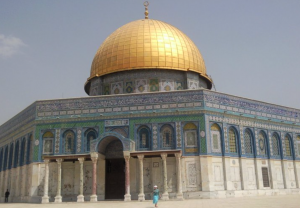
1000 yr-old inscription discovered at a mosque outside Hebron calls Dome of the Rock “Bait al-Maqdess,” an Arabicized version of “Beit Hamikdash,” the Hebrew name for the Temple, proving Jewish ties to the Temple Mount
• Archaeologist: There’s plenty of evidence proving early Islam was influenced by Judaism.
By Yori Yalon
A 1,000-year-old early Muslim inscription provides yet more crucial proof of Jewish ties to the Temple Mount and Jerusalem.
At a conference on Thursday, archaeologists Assaf Avraham and Perez Reuven presented an ancient Muslim inscription that refers to the Dome of the Rock on the Temple Mount as “Bait al-Maqdess,” an Arabicized version of the Hebrew words for the Temple, Beit Hamikdash.
The inscription was discovered at a recently excavated central mosque in the village of Nuba near Hebron.
“At the start of the Muslim period, religious rites were held inside the Dome of the Rock compound that imitated the ceremonies conducted in the Jewish Temple,” Avraham said at the conference.
“The people who conducted those ceremonies would purify themselves, change their clothes, burn incense, anoint the rock with oil, place curtains around the Foundation Stone, just like the ornamental curtain that existed in the [Jewish] Temple.
“In addition, those worshippers would wear ceremonial clothing and use incense burners over the Foundation Stone. These actions teach us that the Muslims saw the Dome of the Rock as the continuance of the Jewish Temple.”
The Muslim findings come on the heels of the discovery last week of an ancient papyrus document from the First Temple period (the seventh century BCE) written in ancient Hebrew script that referenced the city of Jerusalem.
The papyrus is the oldest example of Hebrew writing found to date that mentions Jerusalem, which along with the inscription from the Nuba village mosque demonstrates the Jewish people’s unquestionable ties to the Temple Mount, despite the recent vote by UNESCO to negate that historical link.
“There is plenty of evidence that shows the Jewish influence on the Muslim world at the beginning [of Islam]. Among other things, we can take notice of Muslim coins minted in the Land of Israel in the eighth century by Muslim rulers, which feature the symbol of the menorah of the Temple,” Avraham said.
View original Israel Hayom publication at:
http://www.israelhayom.com/site/newsletter_article.php?id=37507








 Israeli New Shekel Exchange Rate
Israeli New Shekel Exchange Rate